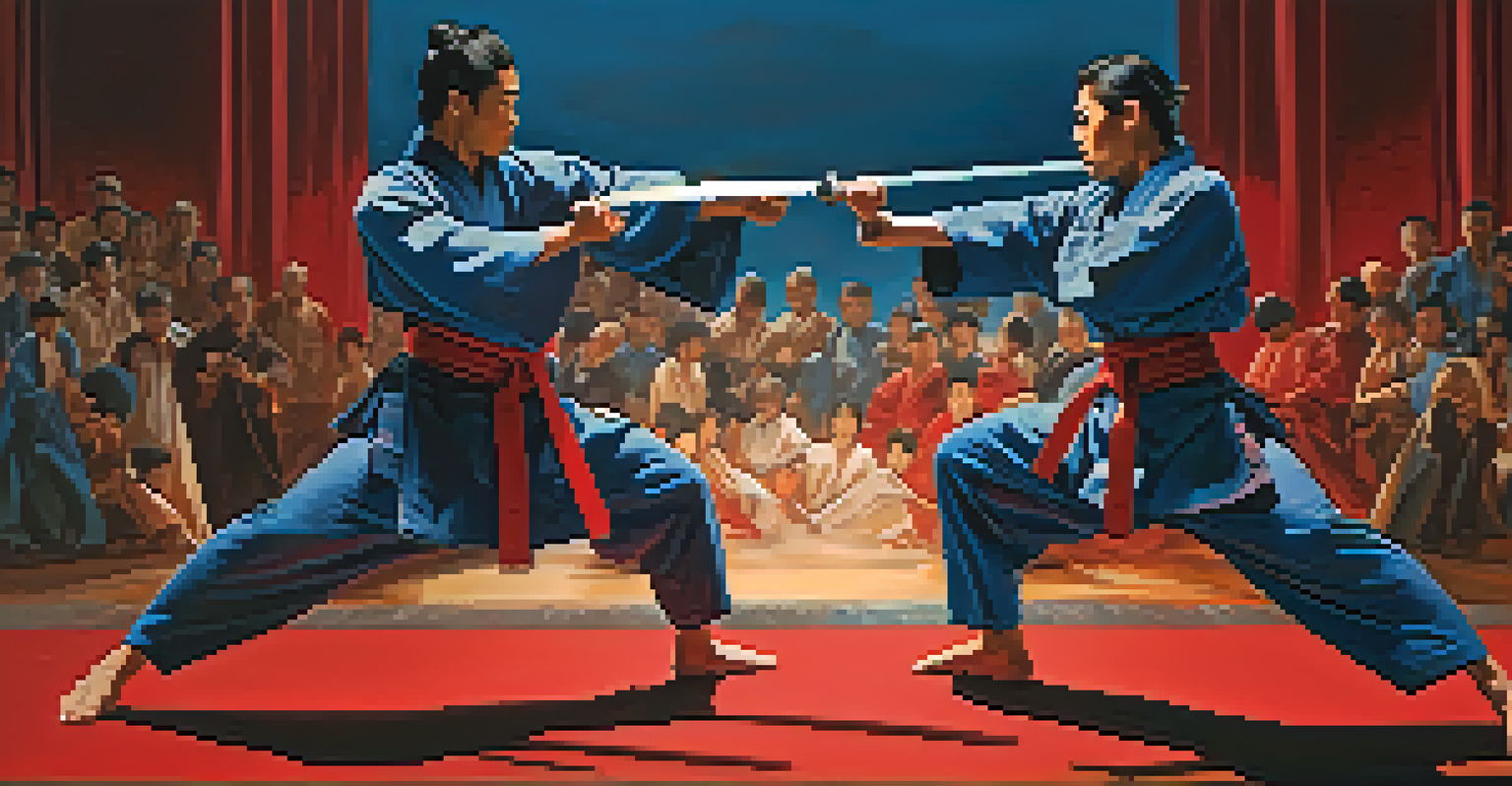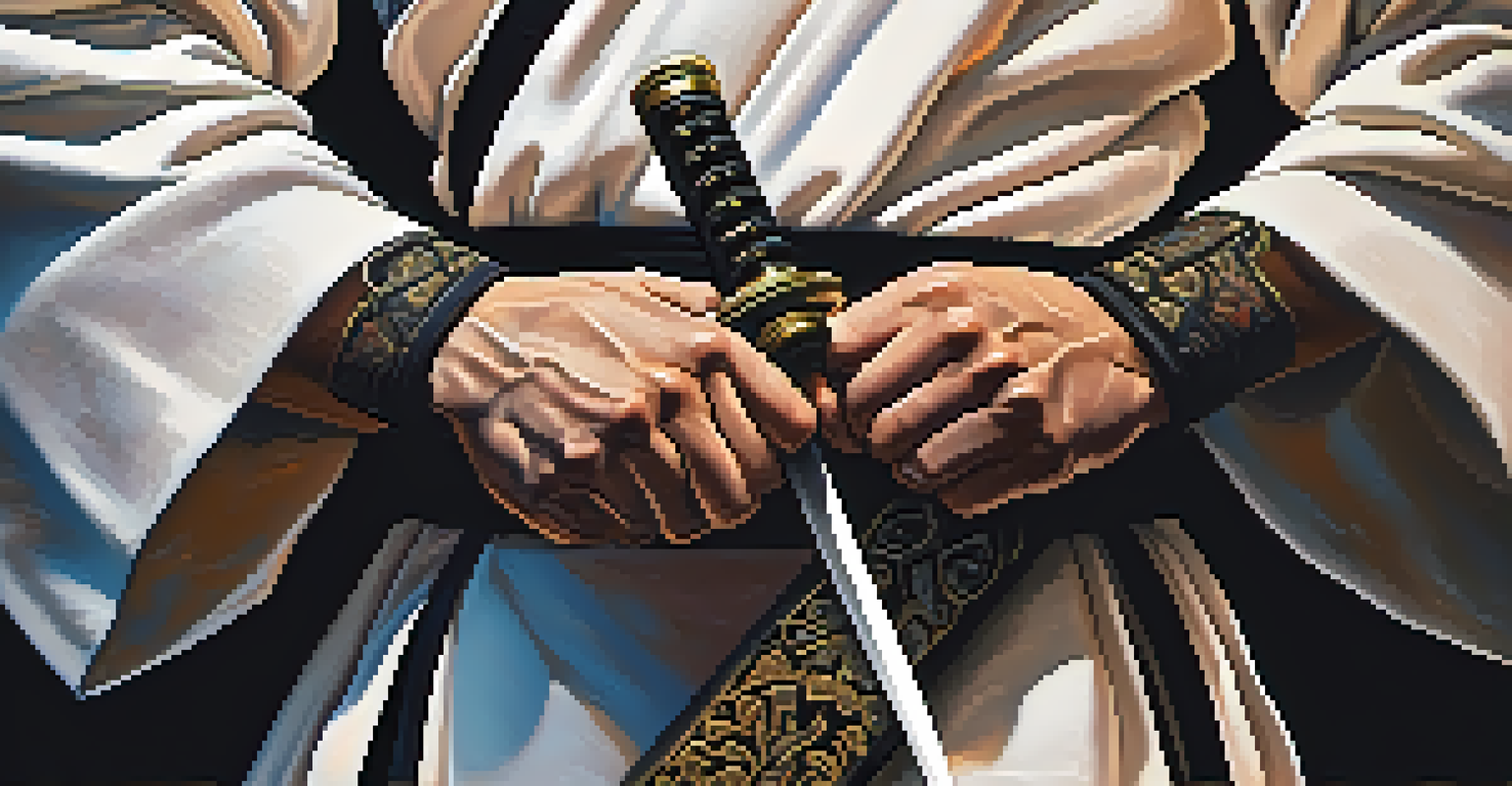Theatrical Elements in Martial Arts Performances and Shows

The Fusion of Martial Arts and Theatre: A Unique Blend
Martial arts and theatre may seem worlds apart at first glance, but they share a rich tapestry of storytelling. Both art forms rely on physical expression to convey emotions and narratives, creating a powerful connection with the audience. In performances, martial artists don’t just showcase their skills; they embody characters and stories, making the fight scenes a form of theatrical storytelling.
Martial arts is not about fighting; it's about building character and confidence.
For instance, think of a traditional kung fu movie, where each fight sequence is meticulously choreographed to reflect a deeper narrative. The movements, the stances, and even the pauses contribute to a storyline that resonates with viewers on an emotional level. This blend of physical prowess and dramatic expression elevates martial arts from mere combat to captivating storytelling.
Ultimately, this fusion enriches both disciplines, allowing martial artists to refine their craft while providing audiences with an experience that entertains and inspires. The artistry in martial arts performances invites viewers to not just watch, but to feel the intensity and passion behind each movement.
Choreography: The Art of Movement in Martial Arts Shows
Choreography in martial arts performances is akin to the choreography in dance; it's all about precise movements that tell a story. Every kick, punch, and block is carefully orchestrated, ensuring that the action flows seamlessly and captivates the audience. This attention to detail transforms martial arts into a visual spectacle, much like a well-rehearsed dance routine.

Consider the intricate fight scenes in films like 'Crouching Tiger, Hidden Dragon.' Each movement is not just about showcasing skill; it's about creating a rhythm and a connection that draws viewers in. This level of choreography requires immense discipline and practice, highlighting the performers' dedication to their craft.
Martial Arts as Storytelling
Martial arts performances blend physical expression and narrative, transforming fight scenes into captivating stories that resonate emotionally with audiences.
Through choreography, martial artists can express emotions and themes, such as conflict, harmony, or perseverance. The synergy between the martial artist's movements and the accompanying music or lighting can amplify these feelings, creating a memorable experience for the audience.
Costumes and Props: Enhancing the Visual Experience
Costumes and props play a pivotal role in martial arts performances, adding layers of visual interest and authenticity. The attire worn by performers often reflects their character’s background, culture, and the narrative they are portraying. For instance, a samurai might wear traditional armor, which not only looks impressive but also tells a story of honor and history.
The art of fighting without fighting is the greatest skill one can possess.
Props, such as swords or staffs, can enhance the drama and complexity of a performance. They are not just tools for fighting; they can symbolize a journey, serve as extensions of the characters, or even represent inner struggles. By incorporating these elements, performers can create a richer narrative that resonates with the audience.
Moreover, the visual impact of costumes and props can evoke emotions, drawing viewers deeper into the story being told. When performers wield their weapons with grace and precision while wearing striking costumes, it elevates the entire experience, making it unforgettable.
Lighting and Sound: Setting the Mood for Performance
Lighting and sound are crucial elements that set the mood and atmosphere in martial arts performances. A well-placed spotlight can create dramatic tension, highlighting the intensity of a fight scene or the vulnerability of a character. Similarly, the use of shadows can add depth, making each movement appear more dynamic and engaging.
Sound effects enhance the experience by adding another layer of immersion. The whoosh of a sword slicing through the air or the impact of a punch can make the audience feel as if they are right in the middle of the action. Coupled with background music, these elements help to build suspense and evoke emotions, guiding the audience's responses throughout the performance.
Choreography Enhances Experience
The intricate choreography in martial arts showcases precise movements that create a rhythm and emotional connection, similar to that found in dance.
Together, lighting and sound create a sensory experience that captivates and transports viewers into the world of martial arts. The combination of visual and auditory cues makes each performance unique, ensuring that no two shows are ever the same.
Narrative Structure: Crafting Compelling Martial Arts Stories
At the heart of every great martial arts performance is a compelling narrative structure. Just like a classic story, performances typically follow a journey, often involving a hero's struggle, growth, and eventual triumph. This familiar arc resonates with audiences, making it easier for them to connect emotionally with the characters and their journeys.
Think of iconic films like 'The Karate Kid,' where the protagonist undergoes trials and tribulations to become a skilled martial artist. These narratives not only entertain but also inspire viewers, often imparting valuable life lessons about perseverance, discipline, and the importance of overcoming obstacles.
By weaving a strong narrative into martial arts performances, artists can elevate their craft from mere combat to a powerful storytelling medium. This connection to the audience is critical, as it transforms the performance into an experience that lingers long after the final bow.
Cultural Significance: Honoring Traditions in Performance
Martial arts are deeply rooted in cultural traditions, and performances often pay homage to these rich histories. Each style, whether it's kung fu, capoeira, or karate, carries its own unique customs, philosophies, and stories. These elements are often woven into performances, allowing audiences to appreciate not just the physicality, but also the cultural significance behind the art.
For instance, many traditional martial arts performances incorporate rituals, music, and forms unique to their heritage. This not only educates viewers about the cultural background but also reinforces the importance of preserving these traditions. When performers honor their lineage, it creates a deeper connection with the audience, fostering respect and appreciation for the art form.
Cultural Roots and Audience Engagement
Performances honor cultural traditions while engaging audiences, fostering a sense of community and shared appreciation for the art form.
Moreover, this cultural significance can inspire a sense of unity, as audiences from diverse backgrounds come together to celebrate the art of martial arts. It highlights the universal themes of struggle, growth, and the quest for mastery that resonate across cultures.
Audience Engagement: Creating an Interactive Experience
Audience engagement is a vital aspect of martial arts performances, transforming passive viewers into active participants. Performers often break the fourth wall, inviting the audience to cheer, gasp, or even participate in the action. This interaction creates an electric atmosphere, making viewers feel like they are part of the story unfolding on stage.
Consider how some performances include moments where the audience is encouraged to respond, whether through applause or verbal reactions. This can amplify the emotional weight of a scene, enhancing the overall experience. When the audience feels involved, their investment in the performance increases, leading to a more memorable event.

Ultimately, this sense of engagement fosters a community atmosphere, where shared experiences make the performance more enjoyable. It highlights the power of martial arts not just as a form of entertainment, but as a collective celebration of skill, artistry, and storytelling.